Matador Network's Blog, page 676
April 2, 2021
The colorful Caribbean island of Curacao is launching a remote worker visa
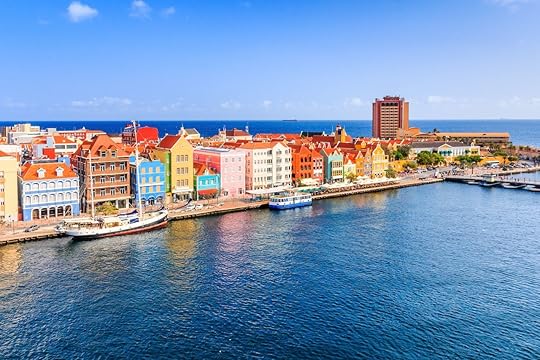
With the rise of working from home and the need to boost the local economy in destinations hurt by the pandemic, a number of destinations have started allowing remote workers to relocate temporarily. The Caribbean island of Curacao is the latest country to announce a remote worker visa that will allow people to live and work on there for up to one year.
In order to be eligible, remote workers need to prove that they have a remote job that is a foreign income source (i.e., you can’t be employed by a company based in Curacao) and present evidence that they have enough money to support themselves. While living there, digital nomads will not be subject to local tax.
Those who choose to apply for the remote work visa and relocate to Curacao will get to enjoy the crystal clear waters of Playa Piskado where they can dive with turtles, eat plenty of fresh seafood, cliff dive at the iconic Playa Forti, and climb through caves at Shete Boka National Park.
The application costs $294 and will be processed within two weeks. The visa grants remote workers a six-month stay, but if that’s not enough time in the sun for you, you can extend it for another six months.
Remote workers are also required to purchase valid international travel insurance with COVID-19 coverage and present a return ticket to be allowed entry into Curacao. Currently, anyone traveling to Curacao needs to show the negative result of a PCR test taken within 72 hours of departure and fill out a Passenger Locator Card.
Other nearby islands are extending similar offers, with Antigua and Barbuda offering up to two years, Barbados allowing a one-year digital nomad visa, and Mauritius with a year-long visa.
For more information on Curacao’s new remote worker visa program, check out its FAQ. 
The post The colorful Caribbean island of Curacao is launching a remote worker visa appeared first on Matador Network.

April 1, 2021
In Northern England, Easter is celebrated with Medieval plays and massive egg-rolling contests

Easter is celebrated differently throughout the Christian world. Some countries put on elaborated religious parades, others launch fireworks, and some create colorful art displays. In most of Britain, like in most of the US, modern Easter festivities are less associated with the resurrection of Jesus Christ than it is with children folk tales and chocolates — the now-ubiquitous Easter Bunny comes at night and hides sweet treats in the homes and yards of well-behaved children for them to hunt and eat in the morning. But in the northwest of England, some centuries-old traditions are preserved and there’s a little more to Easter than an imaginary rabbit and its sugary deliveries. Every year, on Easter weekend, people gather to watch Medieval plays performed on the streets and roll boiled eggs down grassy hills in a tradition known as Egg Pacing.
The Lancashire Pace Egging Play
Photo: philip openshaw/Shutterstock
In Northwest England, mass is not the only entertainment available on Easter weekend. Every year, in rural villages in the historic counties of Cumbria, Yorkshire, and Lancashire, locals and visitors in the know come to watch the revived tradition of the Pace Egging Play.
The Pace Egging Play is a street performance akin to a pantomime with roots in the Middle Ages. While the costumed cast of the play differs slightly from village to village, they all feature the same central characters and plot: St. George, the Patron Saint of England, is involved in a battle against a foreign enemy. During the course of their slapstick sword fighting, Saint George inevitably dies, only to be comically brought back to life by a doctor in an interesting take on the resurrection and the victory of good over evil. Other characters in the play include the Noble Youth, the Soldier Brave, and Toss Pot, a foolish personage donning a straw tail, who traditionally collected money, eggs, and just about anything people could spare as payment, in his basket before the performance started.
The practice of putting on a play on Easter weekend declined in the mid-19th century but was revived after WWII. Traditionally, the Pace Egging Play was a way for working-class locals (known as Egg Pacers) to earn money. They often reenacted the drama in several villages over Easter.
Although not as common nowadays as it a few hundred years ago, the Pace Egging Play is still famously performed in Middleton in North Manchester (on Easter Monday), Bury in Greater Manchester, and Heptonstall in West Yorkshire (both on Good Friday), according to BBC America, as well as in Alpson and Broughton in Furness, Cumbria.
The OG Easter egg rollPace Egging is not all about theatre, however. “Pace” is derived from the Latin “Pascha” meaning Easter, and the egg is a powerful symbol of fertility and birth – two themes that are strongly associated with the resurrection and the spring season.
To celebrate the egg and all it represents at this time of year, the people of England have been decorating them for centuries. Historic UK reported that references to decorated eggs date back all the way to King Edward I (13th and 14th centuries), and the tradition continues to this day. Traditionally, boiled eggs or empty egg shells were dyed with onion skins, but today they are often painted various hues and patterns, or colored with synthetic dyes.

Photo: Visit Preston/Shutterstock
On Easter Monday, in Preston, Lancashire, hundreds of families take their decorated eggs (known as Pace Eggs) and gather in Avenham and Miller Parks, like they have been doing since 1867, to take part in an egg rolling contest (though COVID has forced the cancellation of the event this year). Children set themselves up on top of grassy hills and compete with others to see whose beautiful boiled egg (or sometimes the chocolate version) will make it the furthest without cracking. Not breaking your egg was said to bring good luck. Legend also says that Lancashire witches would use the egg shells left on the hills as boats, so it was traditional for children to destroy them all before the end of the day. The gathering in Preston is the most famous of its kind and features workshops, live music, art performances of all kinds, and an Easter bonnet competition.
The tradition of rolling eggs may sound familiar to Americans, who’ve likely grown up watching the odd annual tradition of the White House’s Easter Egg Roll. Oxford Learner’s Dictionaries reported that the egg rolling contest likely made its way to the United States in the late 19th century thanks to Dolley Madison, the wife of President James Madison. The egg rolling contest originally took place during the Easter weekend “on Capitol Hill in Washington, DC, and later in the grounds of the White House.” COVID notwithstanding, the event still takes place yearly on Easter Monday on the South Lawn, and is one of the oldest annual events in White House history. 
The post In Northern England, Easter is celebrated with Medieval plays and massive egg-rolling contests appeared first on Matador Network.

Outdoors on the Big Island, Hawaii
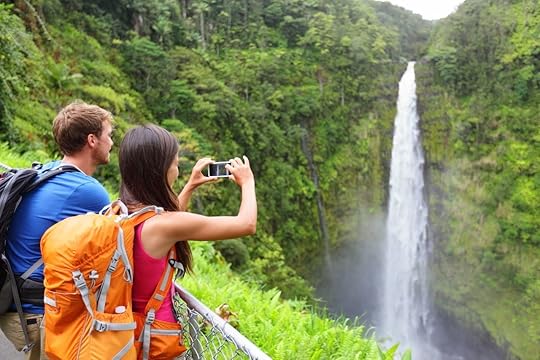
For many people, a trip to Hawaii is a time to just chill out in the warm sunshine and lie on the sand, staring off into the cerulean ocean. That’s one reason many people head to the Kailua-Kona coast of the Island of Hawaii, as it’s the driest and warmest spot of all the Hawaiian islands. But to spend your entire vacation on the Kailua-Kona coast, a place filled with resorts, would be a shame. You’d miss what makes the Island of Hawaii magical, and you’d be passing up on some incredible experiences you can have elsewhere. Here are some of our favorites.
Hike to a green-sand beach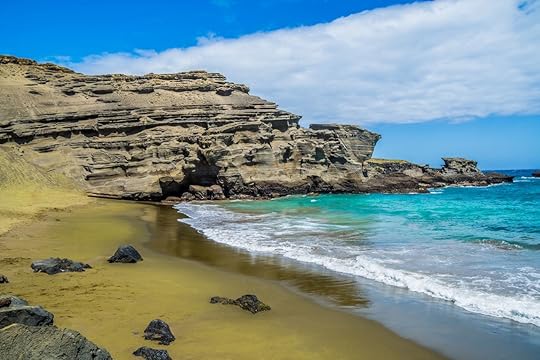
Photo: Damien VERRIER/Shutterstock
One of the most interesting hikes is out to the island’s beguiling green-sand beach on the south end of the island. While we’ve all heard of black-sand beaches, of which Hawaii has a few, and even of pink- or red-sand beaches, which Hawaii also has, green is extremely rare. Papakolea Beach owes its unusual hue to the olivine rock crystals that were spewed out by lava thousands of years ago. It’s just over two miles from the trailhead to the beach, 5.5 miles round-trip. As the trail is quite rugged, proper shoes are recommended.
Walk to a plunging waterfall or trek to the state’s highest peak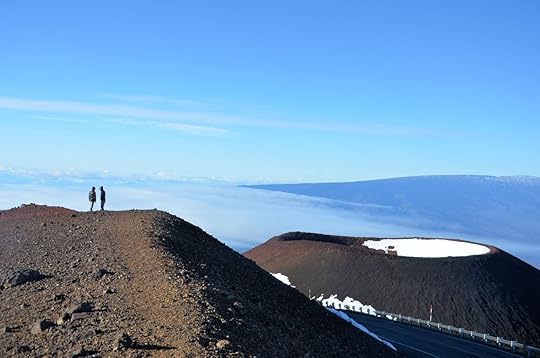
Photo: Aga Monka/Shutterstock
The hiking options on Hawaii Island are seemingly endless. And while there are plenty of wonderful hikes on the Kona-Kohala coast, you’d be missing some spectacular sights if you didn’t venture farther. The half-mile loop to gaze at the 442-foot ‘Akaka Falls in the state park of the same name, just north of Hilo, is an option for even the youngest hikers. At the opposite end of the difficulty spectrum is the ascent of Mauna Kea. Although the six-mile climb (12 miles round-trip) isn’t technically demanding, it requires stamina and pacing — particularly as you reach the thinner air near the 13,803-foot peak. Make sure you check the summit weather forecast before heading out. Beyond avoiding getting caught in a snow flurry, you want to be sure you’ll have mind-blowing panoramic views when you get there.
Mountain bike in the upcountry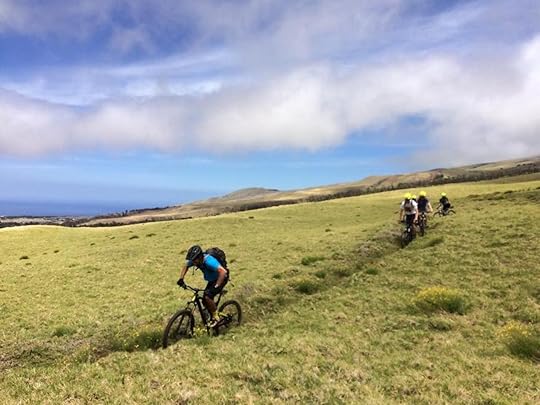
Photo: Big Island Bike Tours/Facebook
The Kalopa Trails in Honokaa, in the northwest corner of the island, are considered some of the best single-track trails in the Hawaiin archipelago. They’re well-maintained while at the same time natural elements like exposed roots are left in place, making for intense technical riding. For a less demanding mountain biking outing, look to the folks at Big Island Bike Tours. One of the best rides is through Anna Ranch, which celebrates the first Hawaiian Cowgirl. This three-hour morning tour in the island’s hilly and cool cattle country takes you up 1,200 feet to a vista point where you can enjoy a snack and learn more about the island’s ranching history. The $189 tour, which includes bike rental, snack, guide, and anything else you may need, is a great way to explore this side of the island. And if you aren’t quite in biking shape, electric mountain bikes are also an option.
Road bike across a desolate lava landscape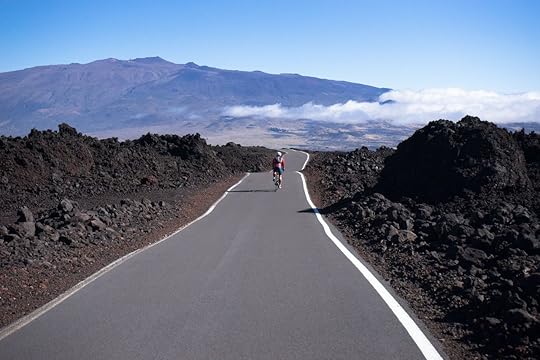
Photo: Tara Kenny/Shutterstock
As the archipelago’s biggest island, Hawaii has plenty of highway real estate to explore on a road bike. One popular spot is the winding, four-mile Old Mamalahoa Highway north of Hilo, which takes you through the rainforest and includes an overlook with views towards Maui. The road is paved but a bit patchy in spots, so bring your tire repair kit. You can rent road bikes (or mountain bikes if you prefer) for $35 per day from Mid Pacific Wheels LLC in Hilo.
Another excellent road biking option is through the lava fields created by the Kilauea Volcano. Paved paths mean a road bike will work for you. If you prefer to go with a guiding service that will provide bikes (in this case hybrid or mountain bikes) but will keep you on paved roads, provide lunch, and fill out the experience with information about the volcano, then try the experts at Volcano Bike Tours. Their five-hour tour is $155 per person.
Horseback riding though Hawaii’s ranchlands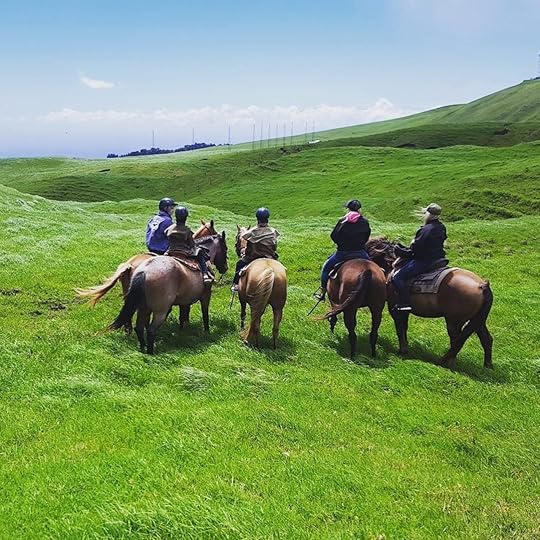
Photo: Na‘alapa Stables/Facebook
Given the Big Island’s thriving cowboy culture, there are plenty of stables offering stunning island tours on horseback. Among them are the Na‘alapa Stables, located on a 12,000-acre working cattle ranch in Kohala with views out over the Pacific. You can take a shorter 1.5-hour tour of the ranch or a longer 2.5-hour tour of the Waipi’o Valley — which is $114 for adults. Paniolo Adventures, on an 11,000-acre ranch on the north end of the island, offers 2.5-hour rides for $99. Its 1.5-hour, $89 sunset ride takes you up to 3,000 feet and gives you a view you’ll not soon forget.
Birdwatch with experts
Photo: Stubblefield Photography/Shutterstock
Normally, we’d be cautious about shelling out $215 per person for a tour. But this one is the real deal, taking you out for the entire day. Including travel time, it’s a 12-hour excursion. We decided to include it here because a lot more people discovered the joys of bird-watching during the pandemic, and Hawaii is one of the most remarkable places to bird-watch in the country. When you go with Hawaii Forest and Trail, you have guides who are dedicated to preserving this beautiful land and to sharing its treasure with others. The tour takes you into a restricted area of the National Wildlife Refuge, where, in addition to spotting some of Hawaii’s rare and endangered avians, you’ll see spiders with fascinating designs and caterpillars that eat insects.
Tour a coffee farm
Photo: Norimoto/Shutterstock
This option will actually keep you close to Kona, but it will explain why Kona coffee has earned this name. It’s in the foothills above the Kona coast that this distinctive Hawaii bean was first planted and harvested. The area has more than a dozen coffee farms you could tour, ending your visit there with a nice hot cup of java. The best known of these is the Kona Coffee Living History Farm, which gives you a closer look at the century-old history of coffee farming in Hawaii, but there’s a fee to visit. You could instead book a free tour online at Rooster Farm, the oldest certified organic Kona coffee farm on the island. Hula Daddy offers private tours at $100 per group; considering that year after year they rake in awards for their coffee, it might be worth it.
Plant a native tree
Photo: Hawaiian Legacy Reforestation Initiative/Facebook
The Hawaii Tourism Authority has used the break in travel as a reset to consider the health and well-being of the islands as it welcomes travelers back. It invites visitors to “malama,” which is taking care of the islands, the planet, and one another. You could pay to donate to have someone else plant a tree through Hawaii Legacy Forest, or you could do it yourself through Hawaii Legacy Tours. They will pick you up wherever you are for a fee that depends on the distance, and take you to Umikoa on the northwest side of the island — starting the official tour at a height of 2,500. The tour may be on foot or in four-wheel-drive vehicles. Access to the area is restricted, so once you’ve learned about the area’s native plants and carefully put your seed into the ground, you might not be able to go back and visit on your own. But you’ll get an individual RFID code to track “your” tree’s progress. 
The post On Hawaii Island, the real adventure is far from the Kailua-Kona coast appeared first on Matador Network.

Where Americans relocated in 2020
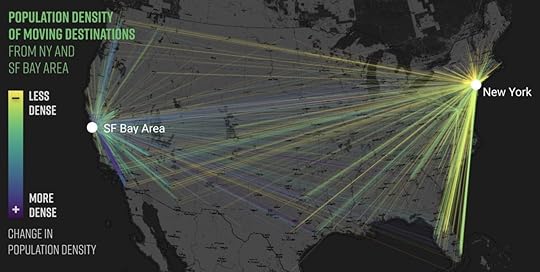
The pandemic has upended lives in a variety of ways. One of those ways has been forcing Americans to reevaluate where they live. Major US cities have experienced something like an exodus this year as people ditch crowded metropolitan areas for destinations with more breathing room. StreetLight Data used transportation metrics to see where, exactly, people went once they left the cities. They compiled a list of the top 25 movement patterns in the spring of 2020 for people who lived in one of the top 10 major metropolitan areas.
These were the top 25 moves:
Miami-Fort Lauderdale-Pompano Beach, FL, to Orlando-Kissimmee-Sanford, FLPhoenix-Mesa-Glendale, AZ, to Chicago-Joliet-Naperville, IL-IN-WINew York-Northern New Jersey-Long Island, NY-NJ-PA, to Miami-Fort Lauderdale-Pompano Beach, FLNew York-Northern New Jersey-Long Island, NY-NJ-PA, to East Stroudsburg, PALos Angeles-Long Beach-Santa Ana, CA, to Phoenix-Mesa-Glendale, AZNew York-Northern New Jersey-Long Island, NY-NJ-PA, to Bridgeport-Stamford-Norwalk, CTNew York-Northern New Jersey-Long Island, NY-NJ-PA, to Poughkeepsie-Newburgh-Middletown, NYNew York-Northern New Jersey-Long Island, NY-NJ-PA, to Atlanta-Sandy Springs-Marietta, GAMiami-Fort Lauderdale-Pompano Beach, FL, to Cape Coral-Fort Myers, FLLos Angeles-Long Beach-Santa Ana, CA, to Bakersfield-Delano, CANew York-Northern New Jersey-Long Island, NY-NJ-PA, to Dallas-Fort Worth-Arlington, TXDallas-Fort Worth-Arlington, TX, to San Antonio-New Braunfels, TXAtlanta-Sandy Springs-Marietta, GA, to Jacksonville, FLAtlanta-Sandy Springs-Marietta, GA, to Gainesville, GANew York-Northern New Jersey-Long Island, NY-NJ-PA, to New Haven-Milford, CTHouston-Sugar Land-Baytown, TX, to Huntsville, TXNew York-Northern New Jersey-Long Island, NY-NJ-PA, to Pittsburgh, PAWashington-Arlington-Alexandria, DC-VA-MD-WV, to Hagerstown-Martinsburg, MD-WVNew York-Northern New Jersey-Long Island, NY-NJ-PA to Boston-Cambridge-Quincy, MA-NHPhiladelphia-Camden-Wilmington, PA-NJ-DE-MD, to Ocean City, NJWashington-Arlington-Alexandria, DC-VA-MD-WV, to Miami-Fort Lauderdale-Pompano Beach, FLLos Angeles-Long Beach-Santa Ana, CA, to Miami-Fort Lauderdale-Pompano Beach, FLWashington-Arlington-Alexandria, DC-VA-MD-WV, to Tampa-St. Petersburg-Clearwater, FLAtlanta-Sandy Springs-Marietta, GA, to Tampa-St. Petersburg-Clearwater, FLMiami-Fort Lauderdale-Pompano Beach, FL, to Atlanta-Sandy Springs-Marietta, GAIn March and April of 2020, people moved to areas that were between 22 and 33 percent less dense than their city of origin. By contrast, in March and April of 2019 people moved to destinations just one and two percent less dense. 
The post The top 25 places Americans relocated to during the pandemic in 2020 appeared first on Matador Network.

Iceland round-trip flight deals
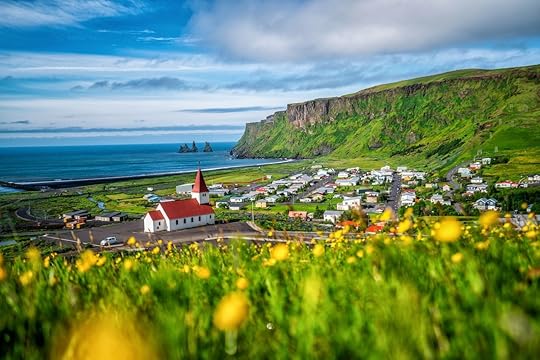
Iceland is positioning itself for a huge tourism boom this summer. The country recently announced that it would be opening its doors to all vaccinated travelers as soon as April 6, 2021, and IcelandAir is capitalizing on the news. The Icelandic airline is offering round-trip flights under $350 and tantalizing vacation packages for just $599.
Travelers who book by April 13, for travel between June 1, 2021, and February 28, 2022, will be able to fly to Iceland for as low as $339 round trip. The sale is valid from several major North American cities, including New York, Boston, Chicago, and Seattle.
IcelandAir’s Michael Raucheisen told Travel & Leisure, “With the news that Iceland has opened [its] borders to all vaccinated passengers, Icelandair is pleased to offer a sale like no other. It has been a long year, but we look forward to connecting North America with Iceland and Europe once again and welcoming you aboard.”
The airline is also offering a winter vacation package starting at $599, including a visit to the new geothermal Sky Lagoon, a northern lights tour by boat, and a one-day pass for the Hop On Hop Off city sightseeing bus. The package is available for departures from October 1, 2021, to February 25, 2022, and must be booked by April 13. 
The post Vaccinated travelers can fly to Iceland this summer for just $339 appeared first on Matador Network.

This map shows the most popular Easter treat in every state
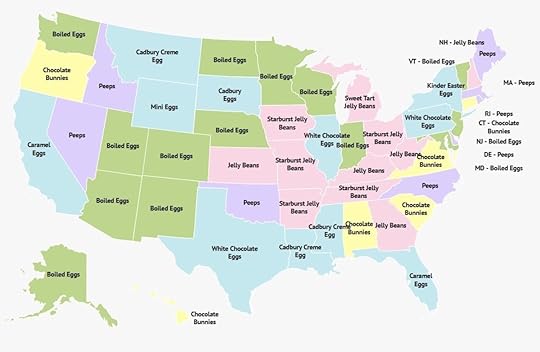
Easter isn’t quite Halloween, but it’s making an admirable attempt. Candy has become a staple of Easter, whether it’s Cadbury Creme Eggs, Jelly Beans, or the controversial Peeps. We might not be able to travel for Easter this year for large family gatherings, but we can still sit at home and stuff our face with chocolates. Much like Halloween candy, each state has its favorite Easter treat, some of which may come as a surprise.
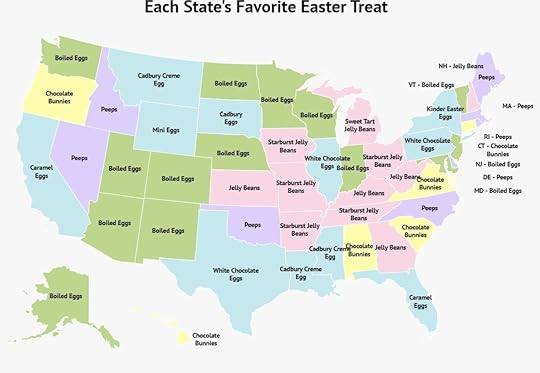
Photo: Zippia
Zippia used Google Trends to compile a map of each state’s favorite Easter candy. It looked at which treats peaked in search volume around Easter around the US, and used the data to create its map.
According to its findings, boiled eggs are the most popular Easter treat in 14 states. While not technically a candy, these are actually an Easter tradition for much of the nation, though we won’t pretend to understand why. Coming in a close second are Peeps (you either love them or hate them), followed by the delicious Cadbury Creme Eggs, which are definitely underperforming their potential.
Some other outliers include Starburst Jelly Beans, Chocolate Bunnies, White Chocolate Eggs, Caramel Eggs, and Mini Eggs. 
The post This map shows the most popular Easter treat in every state appeared first on Matador Network.

After over a year, Puerto Rico will reopen two international airports
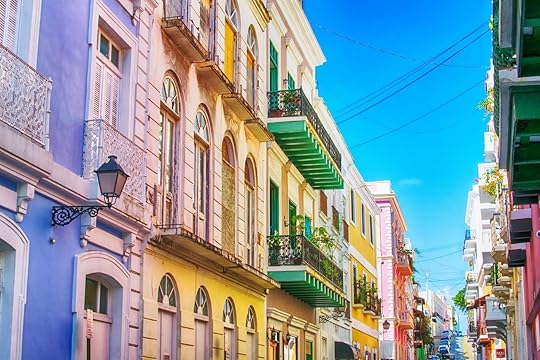
Puerto Rico is looking to encourage travelers to come visit by reopening two of its international airports. While San Juan’s Luis Muñoz Marin International Airport remained open this past year, the airports in Ponce and Aguadilla closed in March 2020.
Mercedita International Airport in Ponce and Rafael Hernández Airport in Aguadilla will reopen to commercial flights starting April 1, 2021 — and that’s no April Fool’s joke.
Airport safety measures will also be in place to mitigate the spread of COVID-19, including thermographic cameras to monitor temperature. The island itself has a face covering mandate in place for public areas, and incoming travelers must complete a travel declaration form through the online health portal and show proof of a negative COVID-19 PCR test.
As explained on Puerto Rico’s official tourism website, the country is a US territory and therefore travelers do not need to provide a negative COVID-19 test result to return to the US. 
The post After over a year, Puerto Rico will reopen two international airports appeared first on Matador Network.

Where to eat in Manhattan Chinatown

Every weekend growing up, Calvin Eng would hop in the car with his parents and drive to Chinatown from their home in Bayridge, Queens, to visit his maternal grandparents. His mother would grocery shop in the neighborhood while Eng visited with his grandparents. They lived in Chinatown for 50 years in the same apartment on Bayard Street that they found when they first immigrated to New York City, and it’s the same apartment Eng’s mom grew up in when she immigrated here in 1964 at the age of 13 (she followed her parents, who set up their new life before she and her siblings arrived).
Manhattan’s Chinatown, in other words, played an influential role in Eng’s life from childhood.
At first, Eng, a young kid understandably eager to fit in with his peers, did not appreciate the tradition.
“To be honest, I was not a fan of Chinatown growing up,” he tells me. “I thought it was dirty and loud, and I was ashamed of being Chinese and having to spend my weekends there. I barely had any Asian friends growing up in school. That’s obviously changed now, but it’s difficult and complicated when you’re young. When you’re young, you just want to fit in with everybody else and be accepted. It feels good to be where I am now, fully embracing my culture and myself.”
Still, his memories of those weekend excursions to Chinatown aren’t unpleasant. Eng remembers ordering lunch with his family, or if it was a special occasion, gathering at a family friend’s restaurant to share a meal “over a large lazy susan table.” Over the years, Eng has watched the neighborhood shift and evolve, as his family’s favorite go-to spots close down or get remodeled until they’re unrecognizable.
“Mei Lai Wah is a super old-school diner across the street from my grandparents’ apartment,” Eng recalls. “My go-to order was their beef cheung fun and baked pork buns because they used actual slices of marinated beef in the rice rolls, as opposed to ground beef, which made all the difference. They also used to sell these fried bowtie-shaped sweets that were piled high in the window, which I can still see very clearly. A lot has changed, and it has since been renovated; the bowties and the sliced beef cheung fun don’t exist there anymore, unfortunately.”
Though Eng once struggled to embrace his identity and heritage, he now calls Manhattan Chinatown his “favorite and most-visited neighborhood in the city.“ Eng speaks Toisan, the Chinese dialect spoken by the older generation of immigrants who live in Chinatown today, which makes it easier for him to navigate. But he’s also honest about how long it took him to feel fully comfortable and at home in Chinatown.
“I would say I have only felt this way for the last five years or so to be honest,” he says. “Like I said, it’s complicated when you grow up. If it wasn’t for the food, I’m not sure if I would have ever felt this way — I’m not sure I would have been given the opportunity to connect with it like I have. So I’m appreciative for that.”
Today, food is a central facet of Eng’s identity and career. As a professional chef, he’s worked at Brooklyn’s Taiwanese-American restaurant and bakery Win Son. This summer, Eng will open Bonnie’s in Williamsburg, a Cantonese-American restaurant that he says is all about “embracing my culture — the culture I spent so long trying to reject growing up in this country.” Eng’s mother is the restaurant’s namesake, a touching tribute to the woman who first introduced him to Cantonese cuisine (she also inspired the CBD-infused chili crisp oil he and a friend recently released, called Loud Grandma). But it wasn’t until he landed one of his first professional cooking jobs at Nom Wah, arguably the most legendary and beloved restaurant in the neighborhood, that he learned to love the neighborhood he grew up with.
“I didn’t fall in love with Chinatown until my time working for Nom Wah in 2016,” he says. “I would grab breakfast from the rice roll carts on my way to work, and grab meat skewers on my way to the train after a shift, all on the same block. Taking the train to and from Chinatown every day, and walking along the streets, was incredibly inspiring for my growth, and it made me want to pursue Chinese food further.”
Manhattan’s Chinatown has been hit hard in the wake of the pandemic, which forced the closure of businesses that had survived the ever-evolving city’s many upheavals for decades. Eng says now is the time to visit Chinatown in order to keep those that remain afloat. And the rash of horrific hate crimes against Asian-Americans sweeping the country makes it even more crucial to support the neighborhood now that safe travel is once again possible.
“I’ve noticed the younger generation is really trying to help preserve and keep Chinatown alive, especially during this last year with coronavirus and the increase in hate crimes,” he says. “It’s super inspiring to see the support from people who are young and motivated, and really proud of their heritage.”
Eng adds that it’s crucial for outsiders to show solidarity with the neighborhood too.
“I would encourage people to visit the spots that don’t have a social media presence, the ones that rely on foot traffic and word of mouth,” he says. ”If you’re not comfortable with indoor dining, hit up multiple spots for grab-and-go dishes and snacks.”
One of his favorite day-long Chinatown routines: “Get a haircut, buy some frozen baos to go, take and share pictures, pick up fresh produce for the week, grab ingredients to make a dinner, pick up take out from your favorite spots,” Eng says. “One of the simplest ways to support the community, to stand with us, is to put your money into our businesses. Chinatown is important to so many people, and a huge tourist attraction as well, so we need to continue to give back to a neighborhood that has been through so much and gives us even more. And the food is delicious.”
Chef Calvin Eng’s top five restaurants in Chinatown and what to order
Photo: Kings Co./Facebook
King’s Kitchen: “Serving Cantonese cuisine, King’s Kitchen has a variety of options, but it is their roast meats that stand out,” Eng says. “Order the cha siu, but ask for half fatty and half lean; you won’t regret it. If that’s not your preference, they do a great job with all of their roast meats, from pig to duck and goose, so you’ll be satisfied no matter what. It’s one of the newcomers that serves a newer generation while still accommodating and serving the locals as well.”
Where: 92 E Broadway, New York, NY 10002
Bo Ky: “Bo Ky is an unassuming and authentic Teochew restaurant that should be on everybody’s list,” Eng says. He recommends trying the noodle soups, and the Whole Country Style Duck, which, he adds, “is very different from the Peking style that most Chinatown establishments offer.”
Where: 80 Bayard St, New York, NY 10013
Grand Street Skewer Cart: “Opening and closing whenever they like, the Grand Street Skewer Cart is one of my go-to spots for street meat,” he says. For a late-night snack, look for the stall near the Grand Street subway station corner. “Go for the lamb skewers, but get it spicy; the amount of fat throughout mixed with the heavy use of cumin works perfectly.”
Where: Near Grand Street subway station
M Star Cafe: “M Star Cafe is a Hong Kong-style cafe and, in my opinion, the best one in NYC,” Eng says. “The aesthetic, vibe, staff, and even the other customers will keep you coming back. Go for the rice noodles with peanut butter and hoisin for an authentic HK dish that you’ll absolutely be ordering again.”
Where: 19 Division St #1, New York, NY 10002
Ho Won Bake: “My mom used to love their wife cakes, which are chewy desserts filled with sweet winter melon,” Eng says. “Chueng fun with dried shrimp, scallions, and pork is my go-to, but make sure you order at least two. It’s across the street from Hong Kong Supermarket, which I frequent very often for dry goods and snacks, and also recommend.”
Where: 146 Hester St A, New York, NY 10013 
The post 5 must-try restaurants in New York City’s Chinatown, according to chef Calvin Eng appeared first on Matador Network.

Stay overnight in these gorgeous lockhouses along Maryland’s historic C&O Canal
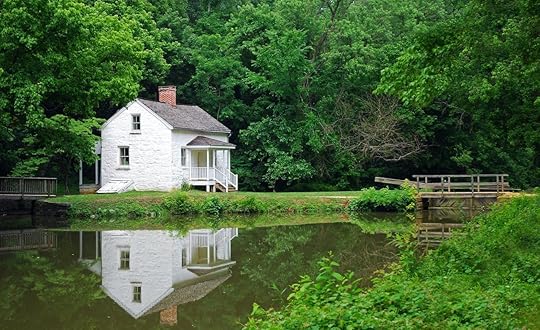
In the early 1800s, industrialists dreamed of a canal that would connect the Eastern Seaboard to the Great Lakes and the Ohio River, shepherding trade and improving transportation between the two regions. Those plans became less grand as support waned, scaling back from Georgetown, DC, to Pittsburgh and eventually just Georgetown to Cumberland, Maryland. The history of the Chesapeake & Ohio Canal is fraught with obstacles, from budget cuts to floods to the Civil War. But throughout these troubling times, the canal could always count on the lockhouse keepers.
The lockhouse keepers lived full-time in humble stone abodes managing the locks, raising and lowering boats between different water levels in the C&O canal. Many of these lockhouses still stand today, and seven of them have been restored by the Canal Trust for overnight guests, be it larger groups like families, weary bikers traversing the 184.5-mile towpath, or solo travelers like me looking to finally leave my quarantine bubble.
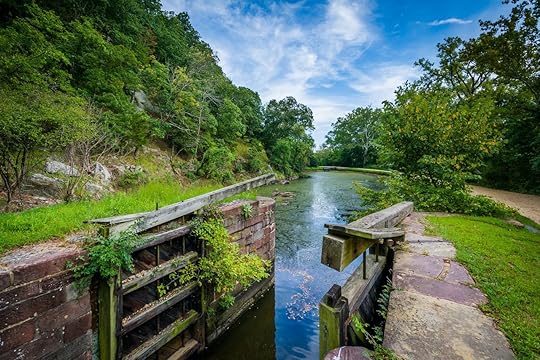
Photo: Jon Bilous/Shutterstock
I spent four days in early 2021 hopping between lockhouses, exploring the C&O Canal and surrounding attractions along the way. It was squarely the off-season, and in the middle of a ban on indoor dining in Maryland, so about as socially distant a getaway could be right now. While there was still plenty to do in late January, I kept thinking how nice the experience would be in the spring with wildflowers blooming, in the summer with crickets chirping, in the fall with bright foliage, and even around the holidays blanketed in snow (for the lockhouses with heat). But for those popular seasons, you’ll have to book in advance to secure one of these exclusive spots.
The Chesapeake and Ohio Canal National Historic Park is actually the 12th most visited park within the National Parks Service — more than Yosemite, Yellowstone, and even the Grand Canyon. You can thank the many DMV (that’s DC, Maryland, and Virginia) locals who take advantage of the canal daily for running, hiking, and biking. What few people I did run into on the towpath were indeed locals, yet almost none knew you could actually stay at the lockhouses they so often strolled past. While lugging my stuff to the door of Lockhouse 22 on my third day, one couple eagerly stopped me to ask what the experience was like — they’d seen the small signs advertising the opportunity in the last year but never pulled the trigger. If you stay overnight at one of the historic properties, you’ll be in the minority of those in on the secret. If you treat the lockhouses like an experiential trail and make a long weekend of it, staying at multiple spots and exploring each surrounding area, you’ll be among the first to do so.
How to book a stay at the lockhouses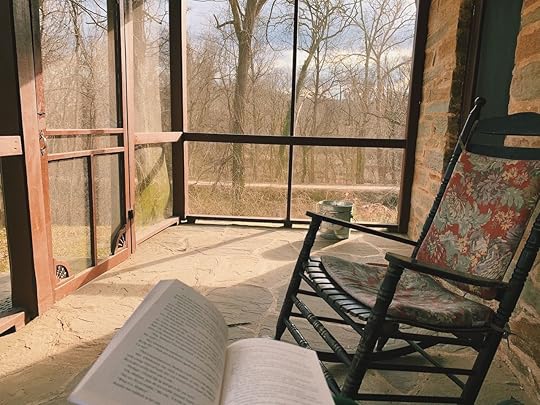
Photo: Laura Reilly
All of the lockhouses are operated by the C&O Canal Trust, a nonprofit that works in partnership with the National Parks Service to restore, protect, and promote the canal. You need to book directly on the Canal Trust website by selecting which lockhouse you want to stay at and confirming dates. You can book up to a year in advance, which is especially recommended if you want to stay during a holiday weekend or around popular events like the annual Heritage Harvest festival in September or the Cherry Blossom Festival every spring in nearby DC. You’ll find plenty of availability throughout the week versus the weekends and more availability in winter. Rates start at $110 a night, and the money goes towards the Canal Trust’s work maintaining these beautiful properties and restoring additional lockhouses. 2021 marks the 50th anniversary of the creation of the Chesapeake and Ohio Canal National Historic Park, and while COVID is putting a pin in some of the planned events, this will still be a busy celebratory summer. The end of August will see the 45th annual “Canal Days” event in Williamsport along with a World Canal Conference in Hagerstown for canal enthusiasts. You can also purchase gift certificates.
What to expect at the lockhouses
Photo: Deeper Look Photography/Shutterstock
Every lockhouse offers its own unique experience, but some are more suitable than others depending on your desired level of comfort and amenities. They can all sleep eight people, but linens and pillows are not provided. Some have air conditioning, heat, and other modern luxuries; others don’t have running water or electricity. Note that indoor fireplaces for all lockhouses aren’t functional, but most have outdoor fire pits. Pets and alcoholic beverages are not permitted. In normal times, you’re responsible for cleaning up the place, but during the pandemic, the Canal Trust is employing a professional cleaning service to sanitize the rooms. Still, it’s up to you to carry out trash and leave the lockhouse in tip-top shape. Think of the whole experience like camping indoors.
These are our favorite options based on location, group size, aesthetic, and rusticity.
For staying close to DC: Lockhouse 6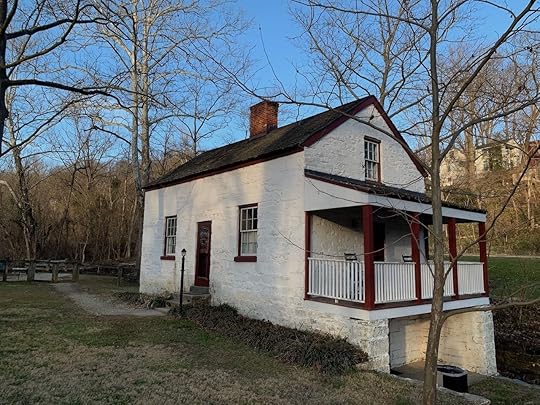
Photo: Laura Reilly
If you’re looking to tack on a visit to the canal as part of a bigger visit to Washington, DC, and don’t want to drive too far away from civilization, Lockhouse 6 is the spot to book. Surrounded by sycamores and steps away from the canal, it feels like you’re away from it all, but in reality, you’re so close to bustling Bethesda and Georgetown that you could order Doordash to the parking lot (speaking from experience). But you’d have a more memorable time spending the day exploring these neighborhoods, popping into their many diverse restaurants and trendy boutiques before retreating to your lockhouse for the evening. If you plan on biking the canal, Georgetown and Bethesda are the easiest places to rent all the gear you need; Griffin Cycle in Bethesda and Big Wheel Bikes in Georgetown are both solid options.
This white-washed stone lockhouse is styled to fit the 1950s in honor of Supreme Court Justice William Douglas’s historic hike to preserve the canal as a linear park after the trade route was shut down in 1924. To fully set the retro mood, connect your phone to the vintage radio, cue up the Canal Trust’s curated ‘50s Spotify playlist, and laze on the colorful mid-century furniture.
Amenities: electricity, A/C, heat, fast cell service, bathroom with tub/shower, modern kitchen, private porch
For a comfortable family vacation: Lockhouse 21, “The Swains”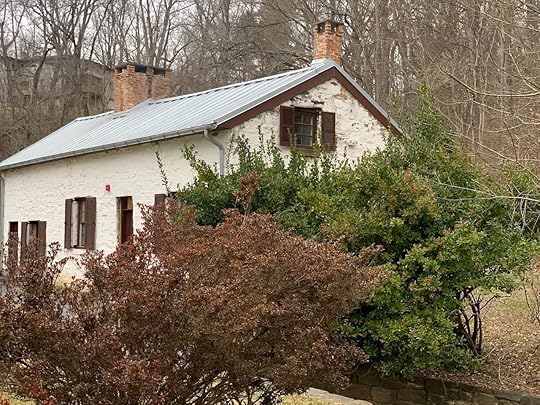
Photo: Laura Reilly
Lockhouse 21, otherwise known as “The Swains” after the family that used to live here, is emblematic of the incredible restoration and preservation work the Canal Trust strives to accomplish. The beautifully restored lockhouse opened in 2019 after three years of rehabilitation work. It’s the most polished, modern lockhouse even though it interprets the year 1916, the year the National Park Service was founded. There’s a large dining room, a huge kitchen, plenty of beds (including a Murphy bed on the ground floor, which is wheelchair accessible), an upstairs living space with comfy furniture and games, and an outdoor fire pit. If you’re coming with a family — whether they’re young children or elderly folk with mobility issues, the swanky Swains is your best bet. If you like what you see, consider donating more to the Canal Trust so they can continue this sort of restoration work elsewhere along the canal.
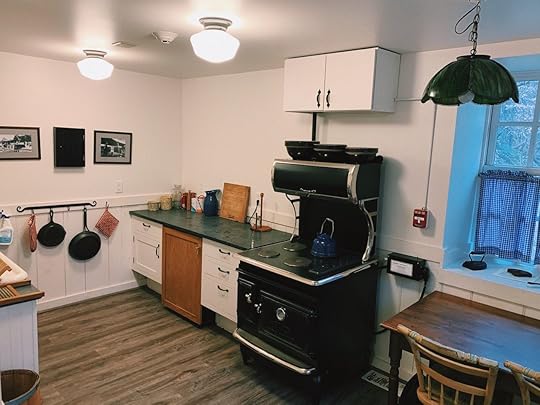
Photo: Laura Reilly
Note that this lockhouse is the least secluded of the bunch, sitting right in the parking lot of one of the busiest canal entry points. But once the park closes, you’ll have one of the best views of both the canal and the Potomac River all to yourself. The tradeoff for not being remote is easy access to the Potomac Village Shopping Center, which houses a large Safeway grocery store, Starbucks, the gourmet Market at River Falls, and the incredibly indulgent Vie de France bakery where you can grab a few baguettes for the lockhouse.
Amenities: electricity, A/C, heat, bathroom with tub/shower, kitchen, fire ring, ADA-accessible
For the best Instagram pic: Lockhouse 10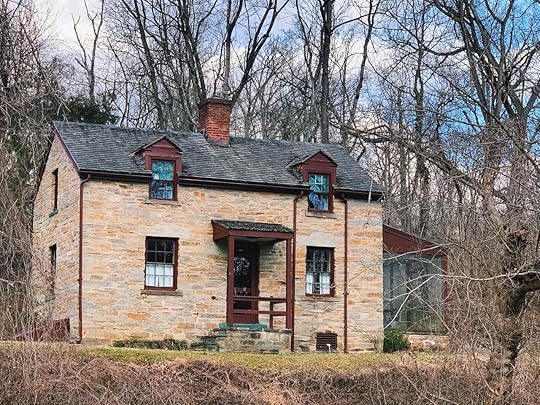
Photo: Laura Reilly
When it comes to adorable aesthetics, there’s no beating Lockhouse 10. Styled after the 1930s and shrouded in greenery, this lockhouse is painted beautiful pastel colors, has lovely 1930s kitchen appliances and decor, and comes with a private screened-in porch with cozy rocking chairs. It’s also fairly close to the Bethesda area and nearby towns Cabin John and Glen Echo.
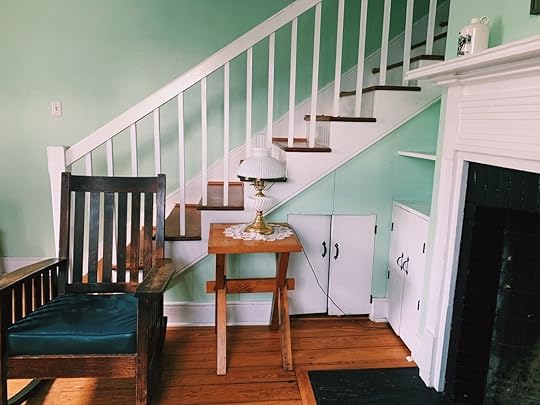
Photo: Laura Reilly
Whether you read a book on the porch, roast marshmallows at the fire pit, or go birdwatching in the surrounding forest, you can expect total relaxation and an enviable Instagram pic at Lockhouse 10. Perfect for families, couples, or a solo getaway.
Amenities: electricity, A/C, heat, fast cell service, bathroom with tub/shower, kitchen, private screened-in porch, fire ring
For a rustic step back in time: Lockhouse 22, 25, or 28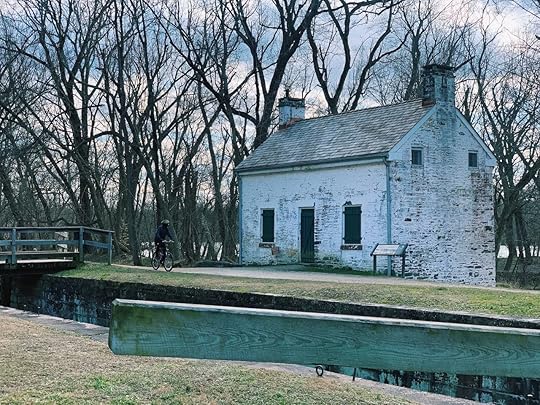
Photo: Laura Reilly
If you’re coming in winter or on a cold rainy day, stop thinking of these rustic lockhouses as a house, and start thinking of it as a tent made of stone — capable of blocking out the wind but not keeping you any warmer than you’d be outside. All three of these lockhouses depict the mid-1800s and lack modern amenities like heat, water, and electricity. I stayed at Lockhouse 22 in the dead of January, and while I really thought I could handle the cold thanks to all my camping gear and hand warmers, it was a massive struggle by lantern light. Then again, I’m the type of person that sleeps in fuzzy pajamas even when it’s 80 degrees out. If you’re a seasoned camper and don’t mind the chill, you could stay in these lockhouses in the colder months. They’ll certainly be available. Otherwise, it’s best to opt for one of the more luxurious options.
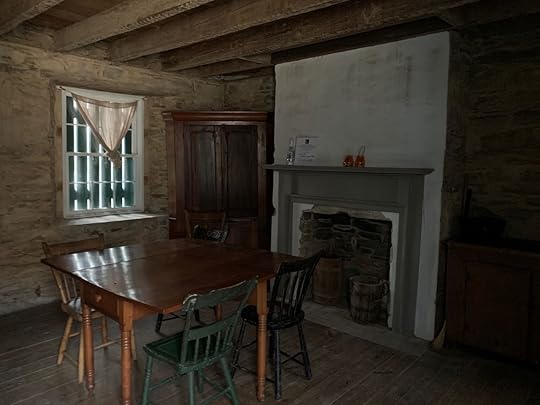
Photo: Laura Reilly
Thankfully, though, Maryland is known for its mild year-round weather. Things start warming up in the Mid-Atlantic around March and stay warm deep into September. These would be perfectly great options for the summer when you relax by the fire ring outside. The Canal Trust has even had families celebrate an Americana-infused Thanksgiving at the rustic lockhouses, cooking over the fire and playing old-fashioned games. Civil War history buffs will especially get a kick out of staying in period-authentic lodging while exploring the nearby Civil War Trail.
Amenities: Fire ring, picnic table, outdoor portable toilet. No running water (water pump at the towpath between April and November), no electricity, no light, no heat. Lockhouse 28 is wheelchair accessible, but a half-mile from the nearest parking.
For a remote, quiet retreat: Lockhouse 49, “Four Locks”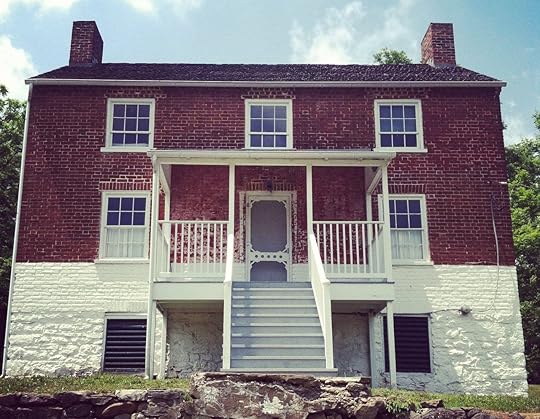
Photo: C&O Canal Trust/Facebook
Nearly all of the lockhouses are clustered around Montgomery County’s quaint small towns or within a short drive to bigger cities like Rockville or DC. Lockhouse 49 is the exception, set way up in Western Maryland at the border of Pennsylvania and a short drive from West Virginia. Take a slow, long drive up the C&O Canal Scenic Byway, stopping at towns like Brunswick and Hagerstown along the way. Hiking opportunities abound, as do wineries like Antietam Creek Vineyards and Blue Mountain Wine Crafters. The tree-lined byway would be especially pretty in the fall when seasonal farm stands are in full swing. There are also lots of Civil War historic sites in Maryland and across the zigzagging state borders; the iconic Harpers Ferry National Historic Park in West Virginia is an easily accessible short detour.
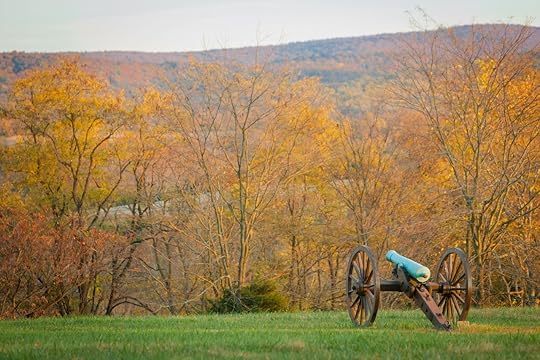
Photo: christianthiel.net/Shutterstock
At the end of your drive, retreat to Lockhouse 49, otherwise known as “Four Locks.” Set in the 1920s, this large lockhouse was once a mainstay of the canal community. Lockhouse 49 is a good balance between modern luxuries and a more historically accurate retreat, offering perks like baseboard heat and electricity, but forcing you to go outside for the bathroom and water pump. It’s another great option for a family or for anyone hoping to experience everything the C&O Canal has to offer, top to bottom.
Amenities: electric baseboard heat, fire ring, picnic table, close to a boat ramp, portable toilet, water pump nearby year-round 
The post Stay overnight in these gorgeous lockhouses along Maryland’s historic C&O Canal appeared first on Matador Network.

Why RVing is the best way to explore
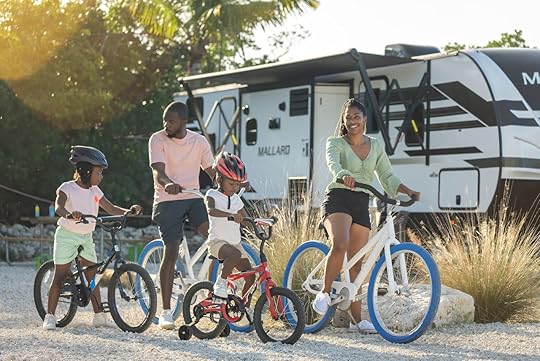
There are a lot of ways to see the world, but RV camping has always been the coolest. Combine the classic road trip with the allure of the great outdoors, add an RV to take you there with the comfort of a home away from home, and you’ve got a recipe for some serious adventure.
According to recent consumer research, nearly 50 million Americans plan to travel by RV this year. Here are some very compelling reasons why you should be one of them:
It’s a safe way to travel.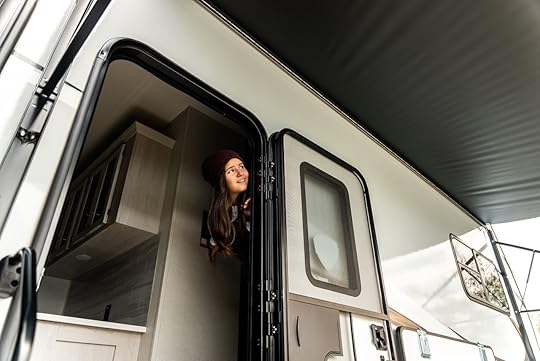
Photo: Tyler Cave
The pandemic interrupted all of our travel plans in a major way, and now that the world is beginning to open back up, many travelers still want to be cautious. Camping with an RV lets you stay in your comfort zone, with everything you need right there in your rig.
The U.S. Travel Association reports that the average American is nearly four times more likely to say they feel safe traveling in a personal vehicle than getting on a domestic flight. On the Association’s list of “safe” activities, visiting a park or campground ranks higher than rental homes and hotels. In fact, it’s second only to taking a road trip.
It’s a lot cheaper than a hotel.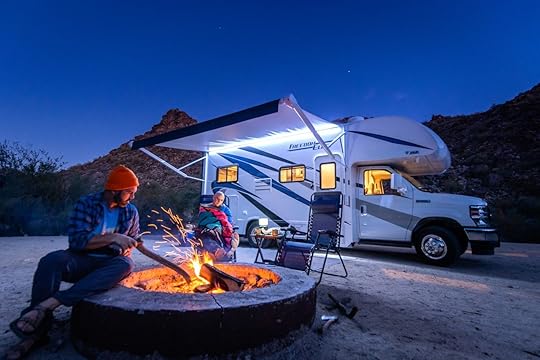
Photo: Brian Lewis
Frequent — or even occasional — travelers know how quickly hotel and other lodging costs can add up, especially if you’re traveling with the whole family. There’s perhaps no form of travel more undeniably cost-efficient than RVing: You can snag a towable RV that sleeps five people for payments that work out to under $5 a day.
Across the country, campground prices generally start at around $20 a night and rarely exceed $75. The average RV spot, with power and water hookups, will run about $30, according to J.D. Power. Any way you slice it, that’s a significant savings over the typical vacation.
It gets you off the beaten path.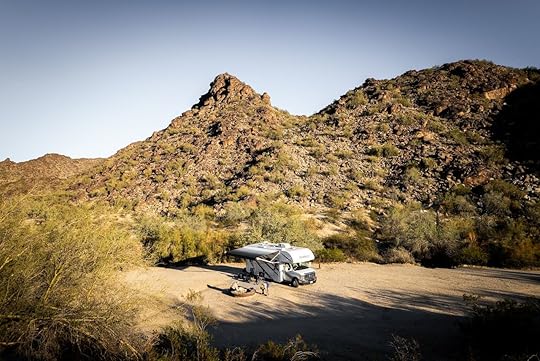
Photo: Tyler Cave
Traveling in a home on wheels can take you places most people never see. Many of America’s most breathtaking spots are far from towns with amenities and lodging. But the trek is always worth it, especially if you have an RV to carry you there.
Drive out into the desert and experience the brilliant International Dark Sky Parks of the American Southwest. Or tow your RV into Maine’s 100 Mile Wilderness, so named for good reason. Maybe find a quiet site on the beach in Northern California and watch the sun set over the Pacific. No need to worry about hotel rooms or rental cars — when you travel by RV, home truly is where you park it.
It doesn’t come with baggage fees.
Photo: Brian Lewis
Ok, so you can’t pack everything — even the biggest mobile homes still have weight limits — but you can get pretty close. Unlike travel on planes and trains, which limit your luggage or charge an arm and a leg to stow it, RV travel means you don’t have to worry so much about packing light.
If you’ve got the storage, you can bring along everything you need to be comfortable for as long as you’re on the road. Maybe that’s mountain bikes for crushing the world-renowned trails around Moab, or perhaps an easel and canvas to sit and paint a moss-draped live oak in Savannah. There are as many styles of RV travel as there are passions to pursue — what will you pack for yours?
It lets you slow down.
Photo: Tyler Cave
A more “traditional” vacation is often planned down to the minute. We’ve all experienced the stress of rushing to catch a flight, check into a hotel, or make it to a dinner reservation. The real magic of RV travel is that it can free you up to do things at your own pace. Spend a whole day exploring a park or museum; take a drive and stop whenever you see something worth stopping for. In fact, you can stop anywhere you want, anytime you want.
When you’re not concerned about getting back to the hotel every night, you’re able to just go with the flow. The ultimate flexibility RV travel offers means your trip is constantly open to spontaneity, and that usually makes things a whole lot more fun.
It’s pet-friendly.
Photo: Brian A Jackson/Shutterstock
This point speaks for itself: You don’t have to leave your furry loved ones at home or fret over placing them in uncomfortable travel carriers on a flight. Welcome aboard, copilot!
It brings you together.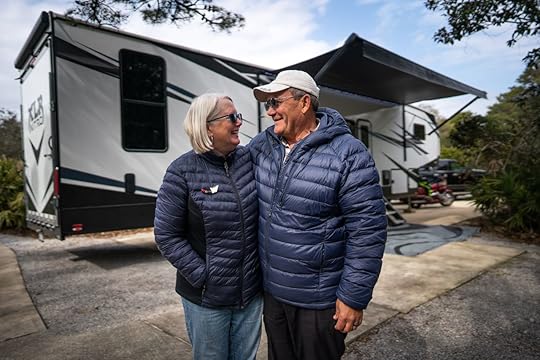
Photo: Tyler Cave
Though some RVs have more living space than you could possibly imagine, even the biggest isn’t exactly palatial. And that’s a good thing. Close quarters mean lots of bonding time for you and your travel companions — and isn’t that the part of a vacation that creates the most rewarding memories?
It’s a true home away from home.
Photo: Tyler Cave
An RV can be like a dream hotel suite you get to stay in anytime (and anywhere) you like. The amenities, luxuries, and upgrades are endless, and an RV designed to your exact specifications will quickly become your happy place.
It can have all the domestic trappings, too. Appliances, furniture, fixtures — it’s all customizable, which means you can add everything you need to keep you and your family feeling totally comfortable and at home, even while you roam far from it.
It gives you an instant community.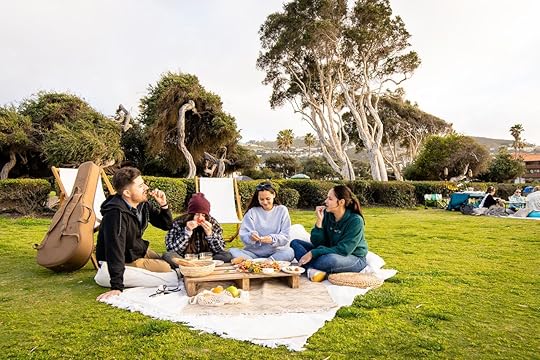
Photo: Brian Lewis
There’s no camaraderie quite like the kind you find at the campground. At a hotel, you might never meet your neighbor, but in RV parks, people from all over seem to uncover common ground. It’s not unusual to find yourself swapping travel tales over the campfire with a new friend. In a world where we’ve all become a bit wary each other, the campground is still a place where no one stays a stranger for long.
In fact, RVing may be a huge community — more than 10 million strong in America alone — but it’s still a small world. And with more than 2,000 Good Sam RV parks and campgrounds across the country, you’re never far from a kindred spirit. No matter where you wander, you’ll find folks who understand the unique joys of RV travel. Ready to join them? 
The post Travel different: Why RV camping is the best way to explore appeared first on Matador Network.

Matador Network's Blog
- Matador Network's profile
- 6 followers



